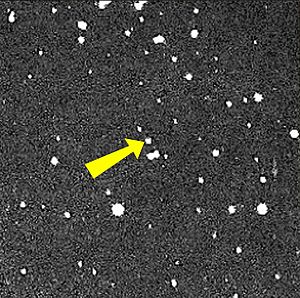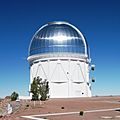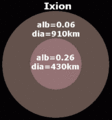28978 Ixion facts for kids
28978 Ixion is a space object found in the Kuiper belt on May 22, 2001. It is a type of object called a plutino, which means it orbits the Sun in a special way that is linked to Neptune's orbit. Scientists think Ixion might even be a dwarf planet, like Pluto.
Ixion is quite large, with a diameter of about 800 kilometers (about 500 miles). This makes it one of the biggest plutinos known. It was named after Ixion, a character from ancient Greek mythology. Before it got its official name, it was known by a temporary name: 2001 KX76.
 |
|
| Discovery | |
|---|---|
| Discovered by | Deep Ecliptic Survey |
| Discovery date | 22 May, 2001 |
| Designations | |
| MPC designation | 28978 Ixion |
| 2001 KX76 | |
| TNO (plutino) | |
| Orbital characteristics | |
| Epoch 31 December, 2006 (JD 2 454 100.5) | |
| Aphelion | 7 370.503 Gm (49.269 AU) |
| Perihelion | 4 501.495 Gm (30.091 AU) |
| 5 935.999 Gm (39.680 AU) | |
| Eccentricity | 0.242 |
| 91 295.847 d (249.95 a) | |
|
Average orbital speed
|
4.66 km/s |
| 268.546° | |
| Inclination | 19.584° |
| 71.028° | |
| 298.779° | |
| Physical characteristics | |
| Dimensions | ~650+260−220 < 822 km diameter |
| < 2.24×106 km² | |
| Volume | < 3.15×108 km³ |
| Mass | ≈3×1020? kg |
|
Mean density
|
2.0? g/cm³ |
| < 0.229 7? m/s² | |
| < 0.434 6? km/s | |
| ? d | |
| Albedo | 0.15-0.37 |
| Temperature | ≈44 K |
|
Spectral type
|
(moderately red; B-V=1.03, V-R=0.61) |
| 19.6 (opposition) | |
| 3.2 | |
Contents
What is 28978 Ixion?
Ixion is a large object that orbits the Sun far beyond Neptune. It is part of the Kuiper belt, a huge ring of icy bodies. This belt is similar to the asteroid belt, but much larger. It contains many small, icy worlds.
How was Ixion discovered?
Ixion was found by a group of scientists called the Deep Ecliptic Survey. They discovered it on May 22, 2001. This survey uses powerful telescopes to look for objects in the outer parts of our Solar System.
What is a Plutino?
Ixion is known as a plutino. This means it has a special orbital relationship with Neptune. For every two times Neptune goes around the Sun, Ixion goes around three times. This is called a 2:3 orbital resonance. This resonance helps keep plutinos stable in their orbits.
Could Ixion be a Dwarf Planet?
Scientists believe Ixion might be a dwarf planet. A dwarf planet is a celestial body that orbits the Sun and is large enough to be rounded by its own gravity. However, it has not cleared its orbit of other debris. Ixion's size, estimated to be around 800 kilometers (500 miles) in diameter, suggests it could fit this description.
Where is Ixion located?
Ixion is located in the Kuiper belt. This region of our Solar System extends from about 30 to 50 AU from the Sun. (One AU is the distance from the Earth to the Sun). The Kuiper belt is home to many icy objects, including dwarf planets like Pluto.
Ixion's Orbit Around the Sun
Ixion takes a very long time to orbit the Sun. It completes one full trip in about 250 Earth years. Its path around the Sun is not a perfect circle; it's more of an oval shape. This means its distance from the Sun changes quite a bit during its long journey.
Naming of Ixion
Before it was officially named Ixion, this object had a temporary name: 2001 KX76. This temporary name is given to newly discovered objects. Once its orbit was well understood, it was given the permanent name 28978 Ixion.
Mythology Behind the Name
The name Ixion comes from Greek mythology. In these ancient stories, Ixion was a king. Many objects in space are named after figures from mythology. This tradition helps astronomers remember and categorize the vast number of objects they discover.
Images for kids
-
Ixion imaged by the MPG/ESO telescope's Wide Field Imager at the La Silla Observatory in 2001
-
Different diameters for Ixion depending on its albedo
See also
 In Spanish: (28978) Ixion para niños
In Spanish: (28978) Ixion para niños
| The Solar System | |||||||
|---|---|---|---|---|---|---|---|
|
|
|||||||
| Sun • Heliosphere |
Planets ☾ = moon(s) ∅ = rings |
Mercury | Venus | Earth ☾ | Mars ☾ | ||
| Jupiter ☾ ∅ | Saturn ☾ ∅ | Uranus ☾ ∅ | Neptune ☾ ∅ | ||||
| Dwarf planets | Ceres | Pluto ☾ | Haumea ☾ | Makemake | |||
| Eris ☾ | |||||||
| Small Solar System bodies |
Asteroids (minor planets) |
Groups and families: Vulcanoids · Near-Earth asteroids · Asteroid belt Jupiter Trojans · Centaurs · Neptune Trojans · Asteroid moons · Meteoroids · Pallas · Juno · Vesta · Hygiea · Interamnia · Europa |
|||||
| See also the list of asteroids. | |||||||
| Trans- Neptunians |
Kuiper belt – Plutinos: Orcus · Ixion – Cubewanos: Varuna · Quaoar · Huya |
||||||
| Scattered disc: Sedna | |||||||
| Comets | Periodic comets and non-periodic comets Damocloids · Oort cloud |
||||||
| See also the list of solar system objects | |||||||




